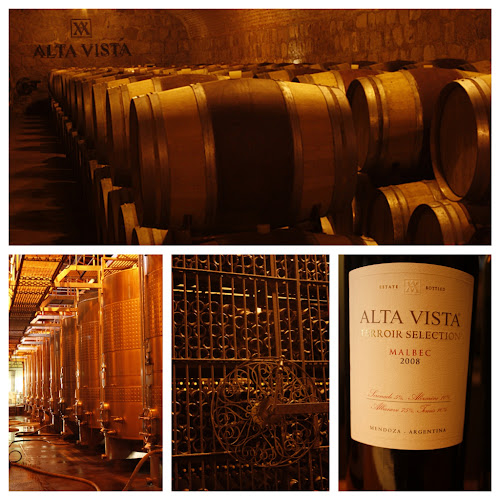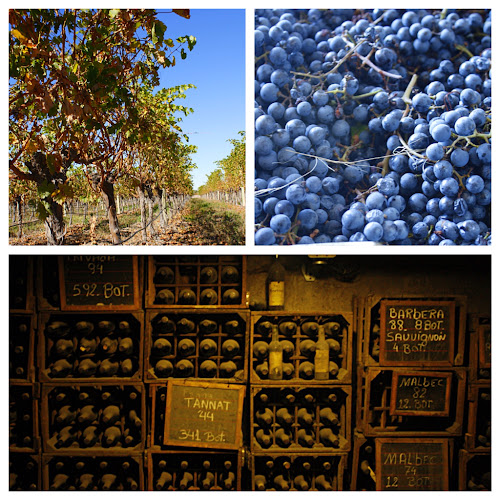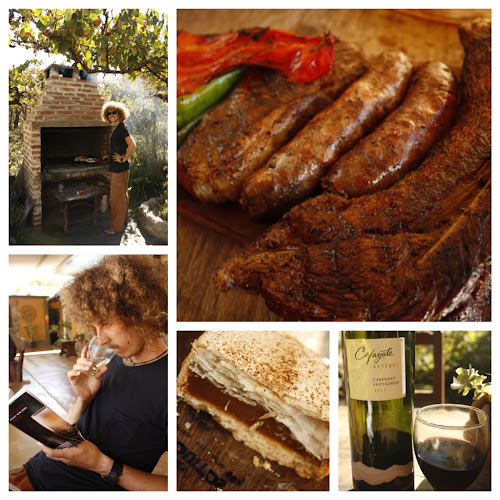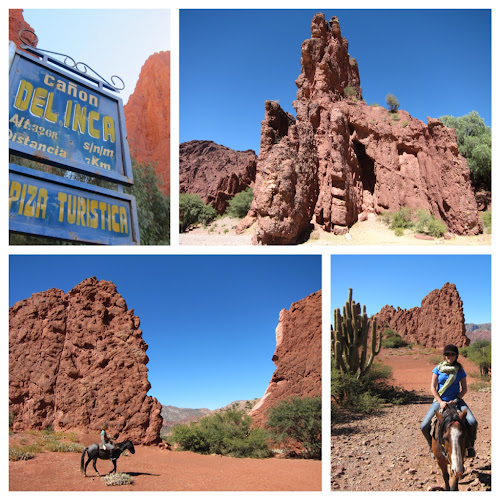With our time in South America drawing to an end we headed to our last port of call, Buenos Aries, which unbeknownst to us this was to be some of the best days of our whole travels. So far that is... After a very interrupted beginning, having been caught in Mendoza due to bus strikes, then opting for a flight only to be delayed for hours, landing at the wrong airport, again having to wait for bus connections to the correct airport, we finally arrived in the capital of Argentina in the very early hours of the morning. Not really in the mood for sight seeing at this point we headed straight to our hostel for some much needed sleep. With so much to do in BA and so little time we had to recharge our batteries to make sure everything would get accomplished.
Our first activity/site seeing trip, funnily enough, actually took us outside of Buenos Aries, well to be honest it took us out of Argentina. Being so close to Uruguay and having the option of the convenient ferry it was hard to pass up the opportunity to see another country and their culture. So for our first few days we actually decided to spend them in Colonia and Montevideo. Our first stop in the World Heritage Listed town of Colonia was a nice change from the other typical towns we visited in South America. Rich in history dating back to 1680, this small quaint town is filled with cobble stone streets, colonial houses and old crumbling walls from previous wars. The people in the town were also really pleasant, always happy to give you directions and find out where you were from. Also whilst the town was a tourist hotspot, being so close to BA, there was no opportunists locals trying to hawk off their 'I heart Uruguay' t-shirts or overpriced tour activity. The other place we visited was the capital of Uruguay, Montevideo. Again this was unlike any other place we have visited so far. Walking through the city itself you really got a sense that the people take pride in where they live, whilst it may of not been the cleanest city in the world, for South America it was well above par. Also again the people were super friendly, always happy to chat and put up with our broken Spanish, although most of the time they went straight for English and even apologized for their small vocabulary. Probably the best part of Montevideo was walking around the old quarters and down near the pier. Most of the old buildings are still in fine condition and filled with an assortment of interesting shops, like 4 generation family run delis and quaint little bakeries housing endless amounts of local baked treats. Just across the road from the main ferry terminal there was also a massive indoor market, which of course we had to investigate. Lucky we did, because as soon as you step inside your senses are instantly hit with the mouth watering smell parrillia. Endless and endless coal fired BBQ's crackle away each day roasting up an arrangement of different cuts and types of meat. It truly was a carnivorously good time. What made it even better was that everyone sat around the BBQ in a bar style set up and you just ordered your meat straight from the grill.
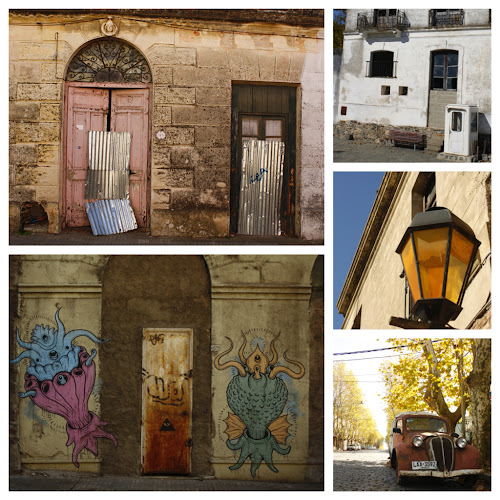

Next on our list of fun things to do in Buenos Aries was to check out the antique markets. Again for those who don't know us we are a little crazy for cool and quirky antiques. So when we went down to San Telmo to check out what they had in store we were both beyond excited and yet completely miserable (mainly for the fact that it was ridiculous cheap and we couldn't take any of it home). Not only was there an entire city block which housed a full indoor antique market, but on Sundays they close off an entire street for approximately 10 blocks and erect more stalls. There was vintage clothes and luggage, brass objects and jewelry, numerous shops containing countless records (which almost had me in tears), they even had one shop solely designated to just grammar phones. Anything you could possibly want could of been found at this market and all at ridiculously cheap prices. Having tortured ourselves quite a lot during our frequent visits to this place, we did manage to also sneak in a few small treats to help decorate the new home when we finally get there.

Of course a trip to South America wouldn't be complete without going to a live soccer match (that's right Kim I called it soccer!). Unfortunately the local favorited team BOCA juniors were playing away that week so we settled for the second favorite River. Due to all the hype about South America soccer matches, we opted to go for a bit more of a safer route and just go with a sort of tour. So one evening we pulled into an awaiting bus with 30 other strangers and one friendly guide and headed to the stadium. As we approached the stadium our guide gave us the run down about what to expect at the match. Firstly she warned us that we will get searched and anything that could be a weapons should stay on the bus, including any form of makeup, perfume, lighters and even keys. Then she told us that as soon as we get there we will all have to stay together and head straight for our seats, absolutely no stopping for food, drinks or the toilet. Also she warned us that it can get a little crazy at times and if for any reason we need to leave immediately we would have a specific meeting point away from the stadium. So having made us double think our decision of not just watching the game on TV she gave us our ticket, with the warning if we lose it we are screwed, and we all headed off for the stadium. After 2 pat downs and 6 ticket checks we finally made it to our seats, which were surprisingly good, second teir on the half way line. As we arrived early the stadium seemed pretty quiet, however it didn't take too long for that to change and within 30 minutes the entire stadium was packed full with roaring fans cheering and singing team songs. The true die hard fans were mostly seated behind the goals, with each team at opposing ends in their own fenced off, barbed wired cage. It seemed a little strange at first but as the game went on it made a lot more sense as these guys took their soccer way to seriously. Not only was there the cheering and team songs but drummers, banners, objects being thrown, flares and lots of abuse and ridicule towards the other team. Just watching the fans was an experience in itself. The game was also really good to watch and whilst it was a little slow for to first half, things started to pick up in the second as the home team River scored 2 easy goals to take the victory. All in all it was a great experience to watch a live game and be apart of all the crazy action.

Another really interesting activity to do in Buenos Aries is go to the cemetery and take a stroll. Our initial expectations of this place were of a green field with time worn gray stones representing the long deceased. Much to our surprise this was not the case here as the entire cemetery was filled with grand mauseleums housing entire families across numerous generations. As we walked through the complex we were amazed at the amount of money and time that went into creating and restoring some of these burial sites. Each site was completely different from the next with some being very basic cement slab coffin holders to the much grander 50m3 monument decorated with heavily detailed statues and plaques. Unfortunately not all of the sites were well kept, as nowadays cremation is more popular and cheaper, and therefore the living family members are just leaving the grand old burial structures rot and crumble, exposing the remains within. Another interesting part of the cemetery was going to see Evitas grave. Whilst the controversial Argentinian woman was originally laid to rest elsewhere her remains were later moved to the grand cemetery with the rest of her family.

We also spent an afternoon walking the streets of the La Boca region, the working class area which contained some of the more colorful houses in BA. Originally the area was built by the Italian immigrants from Geona, nowadays its main attraction is the Caminto a small lane way filled with vividly colorful corrugated buildings. Whilst this area has become very touristy, with cafe's and resturants on every corner and tango dancers asking for photos, the uniqueness and the photogenic aspects of the brightly colored houses made up for the touristy madness. The surrounding streets of the La Boca district were also a site to see, containing beautiful picturesque run down houses and rich autumn colored trees lining rubbish filled streets. The whole area made for a great days worth of photography.
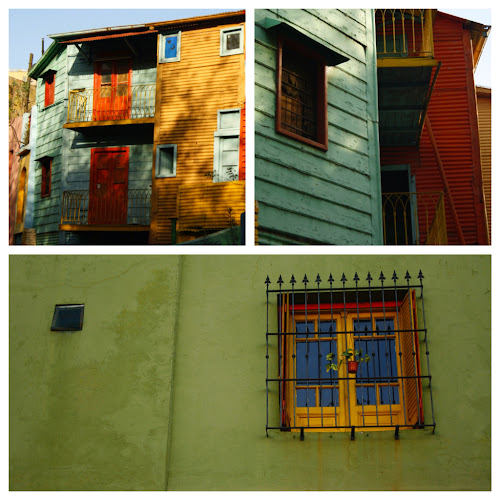
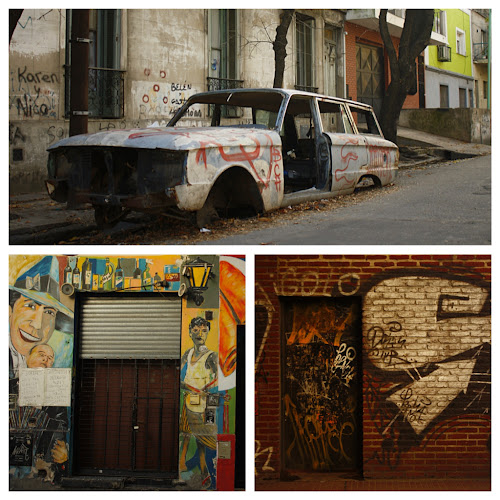
Along with all the sites we also managed to fit in a little catch up time with Louise's cousin and partner who happened to be staying in BA at the time. So one night we caught the subway to their place in Palermo for some dinner and drinks. After dinner we all decided to head out and check out what the nightlife was like as we had heard some very good reports. Going off a suggestion from a girl we met during our travels we decided to check out a place called Franks, a speak easy bar in the heart of Palermo. For those who don't know a speak easy bar is based off the prohibition styles bars of the 1920-30's in the US, a code or riddle is usually distributed and to be allowed entry into the establishment you must present the correct code to the door man. Sounding right up our alley we did a little bit of research and found the clues for the nights code on Facebook. Whilst the code was given in Spanish, with a little help from google translate we quickly deciphered the riddle and headed down to the bar. Just like all the reviews, Franks was an inconspicuous door on a quiet street with a lone man in a suit out the front. So once we reached the door we gave home the secret code, to which he replied with another numerical code and opened the door. Inside the first door there was a narrow alley way, with what is apparently Auenos Aries's best sex shop and a red London style phone booth. So with our new code we picked up the receiver, dialed the code and to our delight the wall beside the phone booth opened granting us entry to the club. Even though it was already 2am at this stage, the bar was in full swing packed with Argentinian locals having a good time. In desperate need for a good cocktail we headed straight for the bar and again to our delight their menu had a great selection of old style cocktails including the house speciality, an Old Fashion. After a few cocktails and with dawn not to far away we all decided to call it quits and head home. It was a great night and a big thanks to Amelia and Burgs for sharing the fun with us.

Overall we had a great time in Buenos Aries and most certainly made use of our short stay there. I think we could of easily stayed longer and we both agreed that overall it was our favorite city in South America. The city itself has so much on offer for a wide range of tastes and it also has some pretty good value dining options too. But more on that in the next blog.
- Ryan -














